Preventive Care
Healthy Mouth, Healthy Life
The human body is a complex puzzle, where one part is intrinsically linked to all the others. In regards to oral health, good dental hygiene involves much more than just your mouth. It is impossible to be fully healthy if you don’t have good oral health.
Oral-systemic health is the idea that oral health is a critical and interconnected component to your overall health and well-being. Studies show that people who have poor oral health are more likely to have other health conditions.
The Oral Health-Body Health Link
Gum disease is a very common dental problem, but it doesn’t just affect your gums. Gum disease has been linked to increased risk for health conditions such as heart disease, stroke, diabetes, inflammation, and osteoporosis.
This goes the other way, too. Many oral concerns like sores, swollen gums, and dry mouth syndrome may be signals of a much bigger problem: leukemia, kidney disease, diabetes, or pancreatic cancer.
Ensuring Whole Body Health
Here are some tips to increase and maintain overall oral and systemic well-being:
- Have an effective oral hygiene routine. Brush twice a day for two minutes each time, floss daily, and clean your tongue.
- Visit your dentist regularly. Professional cleanings and checkups at our office will keep your mouth clean and ensure you’re taking good care of it.
- Eat a healthful diet. A diet rich in fruits, vegetables, whole grains, and natural, unprocessed foods contributes to the overall health of your body. Avoid too much sugar, especially sugary drinks.
- Stay hydrated. Drink plenty of pure, clean water throughout the day. A well-hydrated mouth produces saliva, which not only helps wash away sugar in our mouths, but also helps remove the acids sugars produce which attack our enamel and lead to cavities.
Preventive Care
Preventive dental care is important throughout your life, no matter your age. By practicing good oral hygiene at home and scheduling regular checkups with your dentist, you can help keep your smile bright and healthy for many years to come. Here are a few simple ways that you can prevent the build-up of plaque and cavities:
- Brush your teeth at least twice a day with a soft-bristled toothbrush. Use fluoride toothpaste to remove food particles and plaque from the tooth surfaces. Also be sure to brush the top surface of your tongue; this will remove any extra plaque-causing food particles, and help keep your breath fresh!
- Clean between your teeth by flossing at least once a day. You can also use a mouthwash to help kill bacteria and freshen your breath. Decay-causing bacteria can linger between teeth where toothbrush bristles can't reach. Floss and mouthwash will help remove plaque and food particles from between the teeth and under the gum line.
- Eat a balanced diet, and try to avoid extra-sugary treats. Nutritious foods such as raw vegetables, plain yogurt, cheese, or fruit can help keep your smile healthy.
- Remember to schedule regular checkups with your dentist every six months for a professional teeth cleaning.
- Ask your dentist about dental sealants, protective plastic coatings that can be applied to the chewing surfaces of the back teeth where decay often starts.
- If you play sports, be sure to ask your dentist about special mouthguards designed to protect your smile.
If it's been six months since your last dental checkup, then it's time to contact our practice and schedule your next appointment!
- Brushing Instructions
-
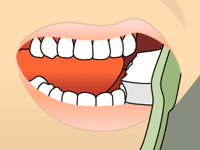
Brushing: Step 1
Place your toothbrush at a 45-degree angle to your gum.
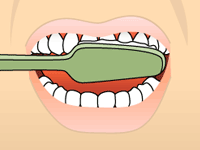
Brushing: Step 2
Brush gently in a circular motion.
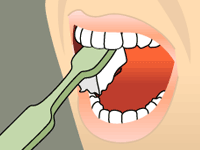
Brushing: Step 3
Brush the outer, inner, and chewing surfaces of each tooth.
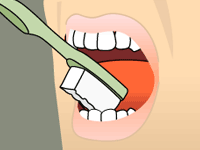
Brushing: Step 4
Use the tip of your brush for the inner surface of your front teeth.
- Flossing Instructions
-
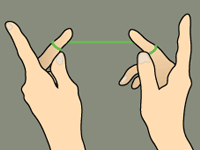
Flossing: Step 1
Wind about 18 inches of floss around your fingers as shown. Most of it should be wrapped around one finger, and the other finger takes it up as the floss is used.
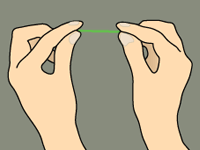
Flossing: Step 2
Use your thumbs and forefingers to guide about one inch of floss between your teeth.
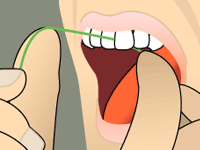
Flossing: Step 3
Holding the floss tightly, gently saw it between your teeth. Then curve the floss into a C-shape against one tooth and gently slide it beneath your gums.
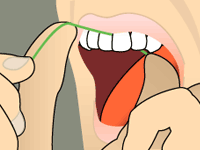
Flossing: Step 4
Slide the floss up and down, repeating for each tooth.
